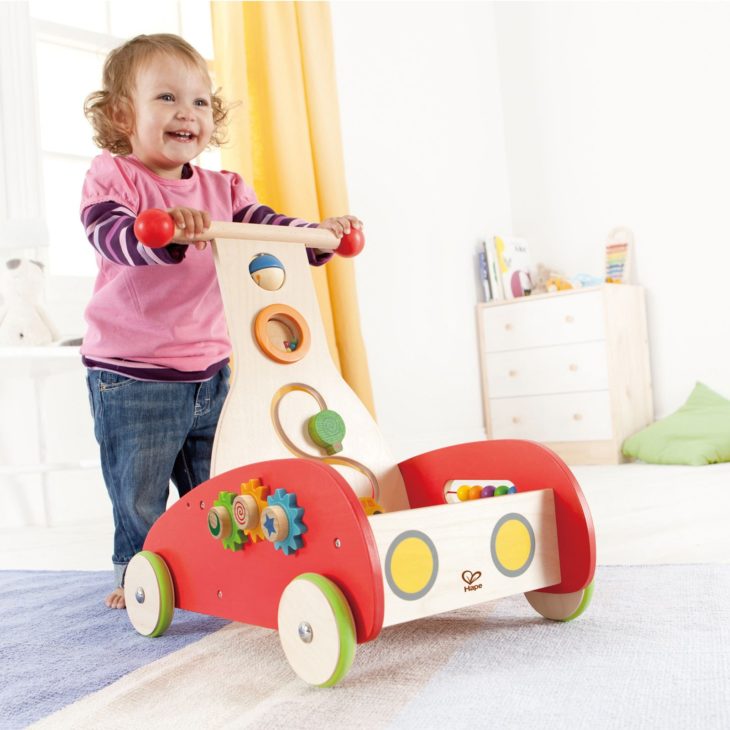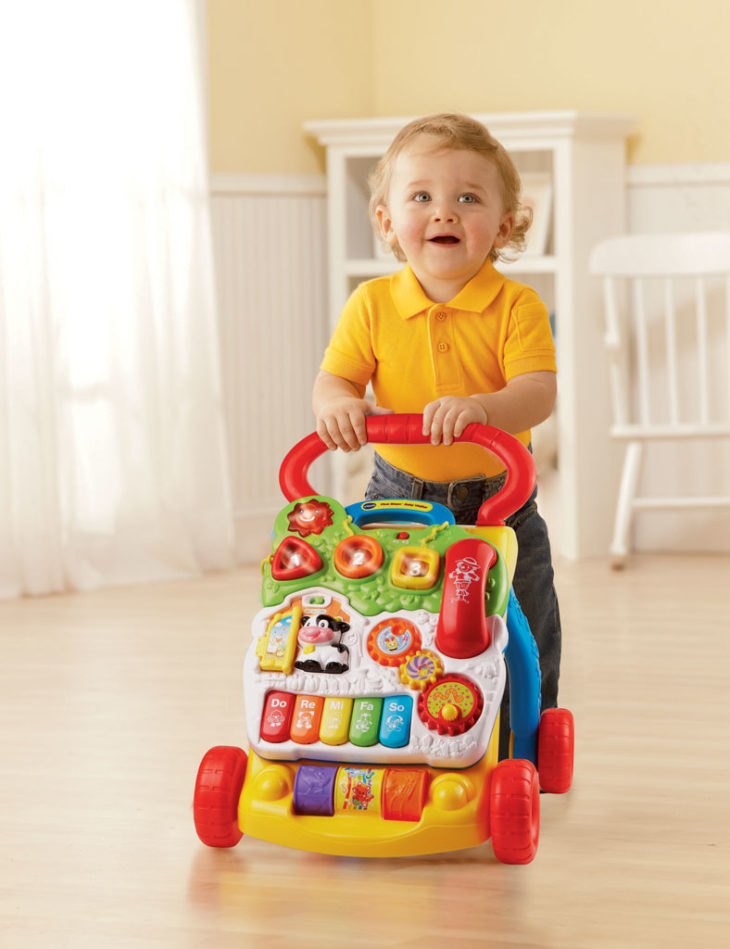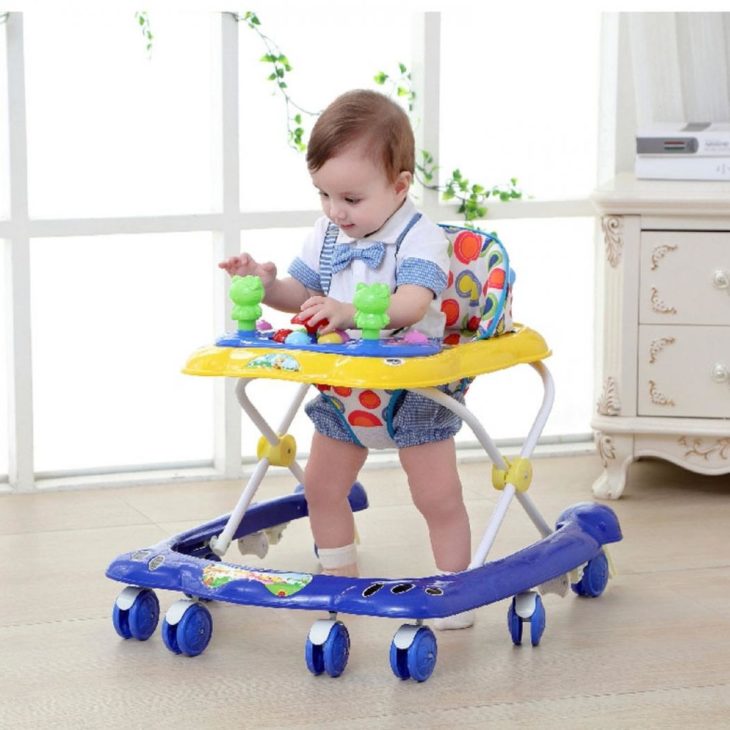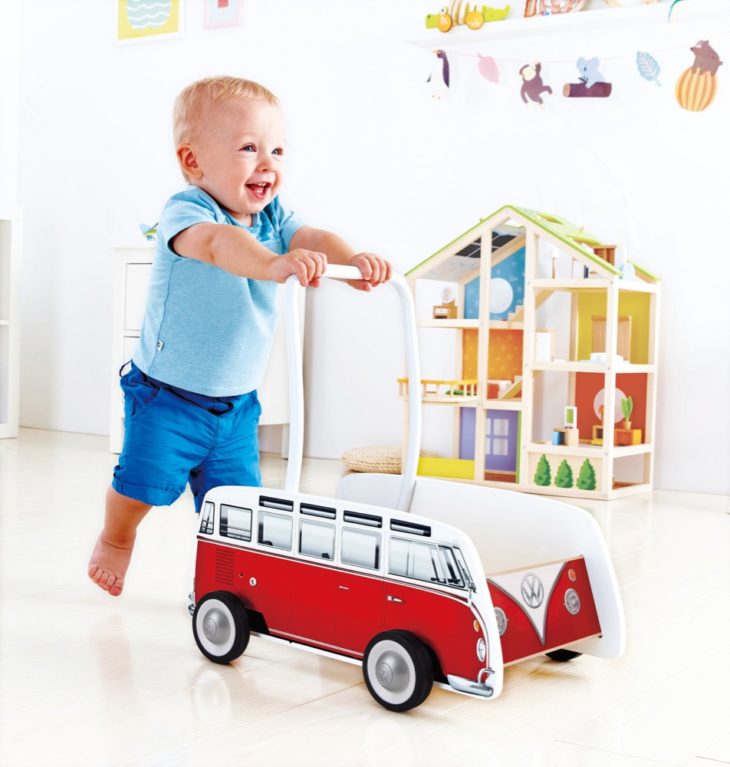Did you know some see those baby walkers as useless devices? Some say they are dangerous for children. It’s a fact that they’re even banned in certain countries.
Well, don’t let those statements put you off the baby walker, however, because not ALL types of baby walkers are evil, and there’s been a lot done in recent years to make even the dangerous types safe.
I’m going to quickly educate you on the essentials of the baby walker world.
Contents
Which walker should you avoid?

Source: popular.reviews
The walkers that most of us grew up using are the ones in the spotlight here! The traditional seated walker is the type that you probably bring to mind. They are usually saucer-shaped and have an opening in the middle for the baby to be seated in. They also have trays with activities and/or toys either in front of a baby or all around the baby to provide entertainment. These are what we’ll call the ‘seated walker’, and these are the type you should be wary of.
Conducted in 2002, one study focused on the delay in the start walking in children who used seated walkers. The delay was seen to be between 11 and 26 days in length between the children who use the walkers and those who didn’t.
It’s also thought that seated walkers could delay walking in children due to the disconnection between sight and feeling. Your baby can’t see their legs move from inside the seated walker. This doesn’t allow them to equate walking to leg movement!
Seated walkers are banned in Canada and have been illegal for sale since 2004. In the US, The American Academy of Pediatrics has called for a ban on the manufacturing and selling of seated infant walkers.
It remains to be seen whether that request will ever come into force because current safety standards for walkers have helped reduce the number of accidents by over 70% since the 1990s.
Any seated walker purchased in the US today should have a design that stops it from easily tipping over, falling downstairs, or trapping the baby in the seat. So if you still feel you want to purchase one, use it responsibly and consider these tips.
A few quick safety tips for your home

Source: ebay
-
Gate your stairs at the top
If you have stairs at home and your little one is mobile, you probably already own a baby gate. Even though baby walker designs have greatly reduced the amount of stair fall accidents, they are still the most dangerous type. It doesn’t matter how wide the base of the walker, a strong baby can still tip one down the stairs. So be safe and add a gate to your stairway.
-
Where can they get to?
Make a baby more mobile they’ll go anywhere they can walk through doorways, close to the fireplace, into swimming pools or onto the roads. Make sure you block their access to anywhere you don’t want them do go.
-
Reassess your baby proofing
You baby-proofed but think again. Your little one in a walker is now standing up, try your best to put away harmful and large items that might come into their reach while in a walker. Clear off heavy items from tables and remove any pans that might be sitting on your stovetop.
Babies in walkers, especially on hard floors, can gather speed quite quickly. Put corners on tables, shelves, and anything else that may be a baby’s head height.
-
Carpet or hardwood?
Loose rugs can easily bunch up underneath the walker and get caught in the wheels. You also need to consider the type of walker you purchase if your home has a lot of carpets. Or switches often between carpet and hardwood. Some walkers are better than others on the carpet (if you want a helpful guide on the best walkers for a carpet to check out this article at yourcub.com).
-
Use a walker in moderation
Finally, it just makes sense, limit your child’s usage of seated baby walkers to 20-30 minutes at a time. Don’t leave them in their walker for hours on end.
So which type of walker is best?

Source: bestpriceupdate
If you’re looking for a walker for your child that will help them through all stages of their walking journey and one that will be useful for a long time, you should consider a simple push walker.
Push walkers pose none of those mentioned above developmental issues with walking. If anything, they encourage walking by allowing a baby some support when they’re doing it (just like you would offer with your fingertips). They also allow a baby to see their legs and make the connection between walking and leg/foot movements.
Push walkers come in several types, there are straightforward trolly style walkers and some you can ride on and also push, but the most versatile are the ‘sit to stand’ walker types. These can work as activity tables whilst your little one is sitting, and the higher activities will encourage them to reach and pull themselves up. When they get to standing, you can take the brakes off, and then they can also use them as walking aids.
Push walkers, whilst offering better development opportunities, still need you to consider all the safety points above. Stairs, corners, heavy objects, and carpet (amongst others) are still things to consider.
When can your baby use a walker?

Source: levidatoys
Baby walkers usually come with recommended age limits and maximum weights. Most manufactured walkers are designed to be used by infants between 4-16 months. If you’re thinking of a seated walker it’s best to introduce them to your baby when she’s able to hold her head up and able to touch the floor with her feet when in a walker.
Some push walkers or sit to stand walkers can serve two purposes. This means they can be introduced earlier to your child, as early as activity centers.
One final note, once your child knows how to toddle or has taken their first steps, seated walkers should not be used! They’ll progress to walking more quickly if you just leave them to practice without the seated walking aid. You can keep your push walker, however, until they’re bored of it!
